 |
||
|
||
| ||
 NVIDIA is keeping on developing a whole cohort of video cards and graphics accelerators. Today they are aimed at a replacement of outdated Riva TNT2/TNT2M64/Vanta by new versions of GeForce2 MX. In fact, at the same sum of money a user gets the same speed in 3D. Besides, the GPU GeForce2 MX instead of the Riva TNT2 video chipset will give some advantages since the GeForce2 MX core is based on the GeForce2 GTS, - Bump Mapping, Hardware T&L, Cube Texturing etc. will take place here despite a relatively low performance. So, the NVIDIA GeForce2 MX200 and GeForce2 MX100 have appeared on the scene. As for a graphics processor, there is nothing cut, and even the frequency remains the same (175 MHz). NVIDIA's favorite way to cut video chipsets lies is restriction of a video memory bandwidth. Do you remember how the Riva TNT2M64, this cheap solution for budget-tight systems, appeared on the market?. Its memory bus was cut not to exceed 64 bits. It means that the memory could receive not more than 64 bits of data per clock cycle (and the less the portion, the lower the performance factor of the memory). So, the GeForce2 MX200 is simply a GeForce2 MX, but with a 64-bit memory bus, and the MX100 has only a 32-bit one! Thus, they have achieved a very good reduction of expenses for production of cards based on these chipsets. By the way, the memory can be used of any type here. Of course, it is disappointing to see how the GeForce2 MX stands idle waiting for data to pump through the memory bus. But it is a marketing policy. Whereas ATI reduces frequency and restricts some functions to obtain cheaper solutions, 3dfx have disabled the second TMU on the Velocity100. NVIDIA has its own approach as well. Note that there is also GeForce2 MX400. On the contrary, the GPU frequency is lifted. Plus, they recommend to use a faster memory with it (though it is the same SDR SDRAM). But the cards mustn't cost more than the current GeForce2 MX based ones. Here are their characteristics:
Cards
1. Leadtek WinFast GeForce2 MX MAXThe Leadtek WinFast GeForce2 MX MAX has AGP x2/x4 interface, 64 MBytes SDR SDRAM located in 8 chips on the right side of the PCB. 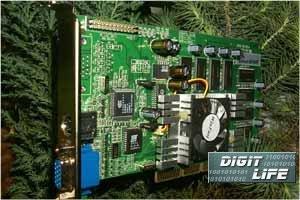 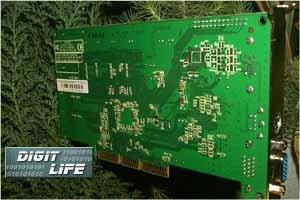 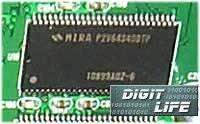 The memory chips are produced by MIRA, an access time is 6ns, what corresponds to 166 MHz of the memory. The card was equipped with 64 MBytes memory, and the frequency from the recommended 183 MHz was reduced to 166 MHz. I thought that the negative experience of producing Inno3D Tornado GeForce2 MX 64 MBytes would not take place again, but unfortunately, Leadtek has also decided to "buy" users with a such memory size on video cards which don't need it. The card's design is very similar to that of the WinFast GeForce2 MX SH Pro and of the DH Pro. The second VGA connector (D-SUB) is not unsoldered, and the second RAMDAC chip is absent. The card follows completely the reference design. Note that Leadtek has changed yellow color of the PCB for bright-green. The cooler has an unusual form what also a distinguishing feature of Leadtek cards. The TV-out installed on the card is supported by the TwinView technology in order to display an image on a TV screen and a computer monitor at the same time, or to extend a desktop on the second signal receiver. We have described it many times in our reviews. 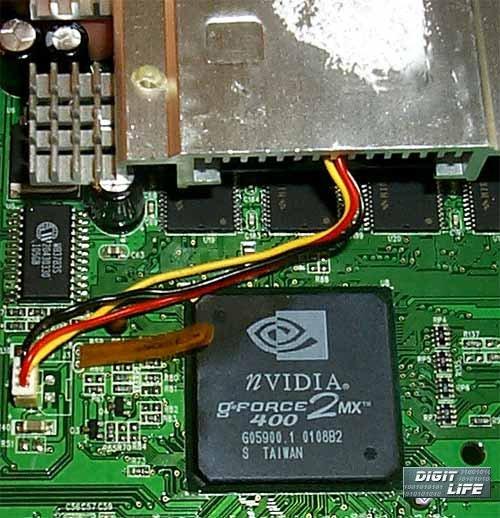 The card is equipped with Hardware Monitoring to control temperatures of the card and the chip (the sensor's lug touches a surface of the GPU - take note of a special hollow in the heat sink for the sensor). 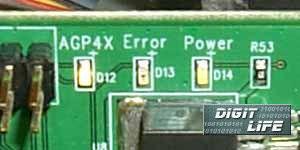 The video card has a chip which is responsible for monitoring (to the left of the sensor on the photo above), and there are three LEDs on the upper part of the card which notify on (left to right):
Parameters of the monitoring are controlled by the WinFox utility which has been considered in the review on Leadtek WinFast GeForce2 MX SH Pro.  The card is shipping in a Retail-package of a usual design. The complete set includes:
Despite the fact that S-Video (TV-out) connector is mounted on the card, owners of old video equipment that lacks for S-Video connectors can use TV-out. OverclockingOn the Leadtek WinFast GeForce2 MX MAX we managed to achieve a stable operation at 240/210 MHz. The overclocking results of the chip are impressive, but you know that on the GeForce2 MX cards a memory bandwidth (i.e. its frequency) is the worst bottleneck for performance. Plus, you should account for the fact that the GPU's initial frequency is 200 MHz, and not 175 as on usual GeForce2 MX cards. 2. Leadtek WinFast GeForce2 MX DH Pro 64 MBytesThe card is similar to the above one, they differ only in the GPU frequency - here we have 175 MHz instead of 200. The memory is the same. The only difference in the PCB is that here we have the TwinView technology what means that the second VGA output is unsoldered and the second RAMDAC chip is installed. It can be a real advantage of the card provided that the TwinView doesn't cause the price to go up too much. The TwinView technology was described in details in our reviews on NVIDIA GeForce2 MX from Leadtek and ASUS AGP-V7100/2V1D. OverclockingWe couldn't overclock the memory of the Leadtek WinFast GeForce2 MX DH Pro 64 MBytes to reach at least the minimal speed increase, that is why overclocking makes no sense here. 3. Leadtek WinFast GeForce2 MX64The Leadtek WinFast GeForce2 MX64 has AGP x2/x4 interface, 32 MBytes SDR SDRAM located in 4 chips on the right side of the PCB. 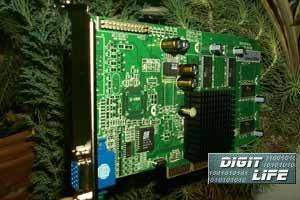 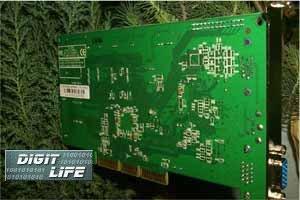 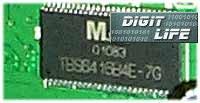 MTech produces the memory chips with 7ns access time what corresponds to 143 MHz. Note that a slow memory bus cut down to 64 bits is not the only factor that affects the speed. The company has equipped the card with a slower memory. That is why its performance will never reach the level of the GeForce2 MX. 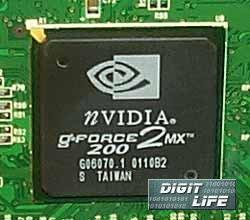 The design of the card doesn't differ from the previous model. The card is lacking for a half of the memory chips and Hardware Monitoring. Plus, the GPU is cooled by a heat sink without a fan. The card is equipped with the GeForce2 MX200 graphics processor. It is apparently differs from a usual one in a production technology, but it works at the same 175 MHz as the GeForce2 MX. 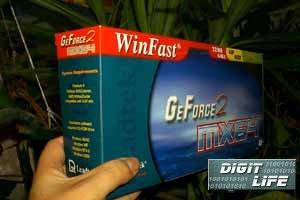 The card is shipping in a smaller Retail-package. What's in the box:
OverclockingOn the Leadtek WinFast GeForce2 MX64 we have reached 220/190 MHz of the memory. Such a moderate result is accounted for by a slow memory installed on the card. Installation and driversTest system configuration for the Leadtek WinFast GeForce2 MX MAX:
The tests were conducted with 6.50 drivers from NVIDIA. For comparison we have taken results of the Hercules Dynamite TNT2 Ultra (with frequencies decreased to the Riva TNT2 level - 125/150 MHz), Leadtek WinFast GeForce2 MX/DVI, AOpen PA256 Deluxe (GeForce2 GTS). Test resultsThe 2D quality is at the level of popular video cards on the GeForce2 MX from top manufacturers. We have discussed this issue many times and found out that 2D quality could greatly depend not only on the manufacturer but also on the definite sample. Now comes 3D quality. Note that the performance of the Leadtek WinFast GeForce2 MX 64 MBytes is the same as of the usual GeForce2 MX, despite the 64-MB RAM. We have already written about it in the review on Inno3D Tornado GeForce2 MX 64 MBytes. That is why the results of this card are not shown on the diagrams, the figures do not differ from the Leadtek WinFast GeForce2 MX/DVI. The following programs were used for estimation 3D performance:
Quake3 Arena
demo002The test on the standard demo002 was carried out in two modes: Fast (shows card's work in 16-bit color) and High Quality (shows card's work in 32-bit color). 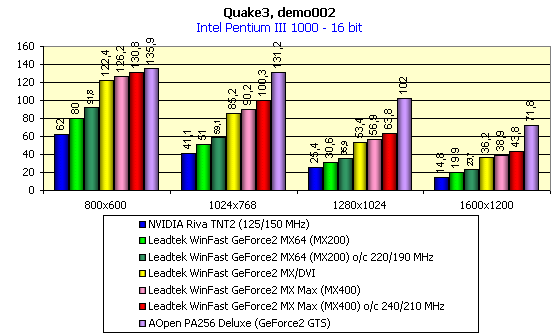 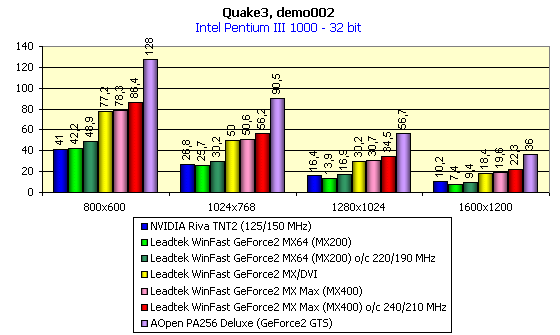 The results of the Leadtek WinFast GeForce2 MX MAX: at the expense of the faster chipset the performance has increased in 16-bit color as compared with the ordinary GeForce2 MX, and in 32-bit color the same frequency of the 6 ns memory doesn't allow the faster GPU to perform better. The Leadtek WinFast GeForce2 MX64 goes on a par with the Riva TNT2 in speed. Though it is unpleasant that this card falls behind even the Riva TNT2 in 32 bit color. And what then can we say about Riva TNT2 Pro or Ultra? Of course, such cards must be equipped with 6 ns memory what would have allowed speed increasing, but just look at the overclocking results! Even at the 190 MHz the memory with a such bus is not able to catch up with the Riva TNT2 which has a normal 128-bit bus. ExpendableThe game is used to show a performance in the Direct3D. 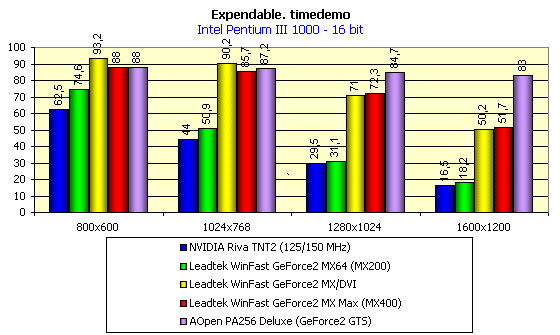 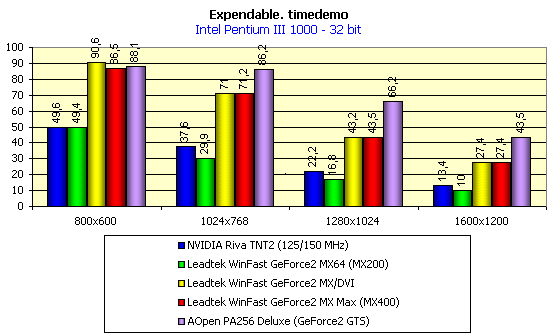 The picture is the same. Let's summarize the performance results of the cards under consideration:
ConclusionThe only I should add is that the GeForce2 MX200 cards from top manufacturers such as Leadtek have a very good 2D quality what the Riva TNT2 cards are lacking for. Highs:
Lows:
Write a comment below. No registration needed!
|
Platform · Video · Multimedia · Mobile · Other || About us & Privacy policy · Twitter · Facebook Copyright © Byrds Research & Publishing, Ltd., 1997–2011. All rights reserved. |